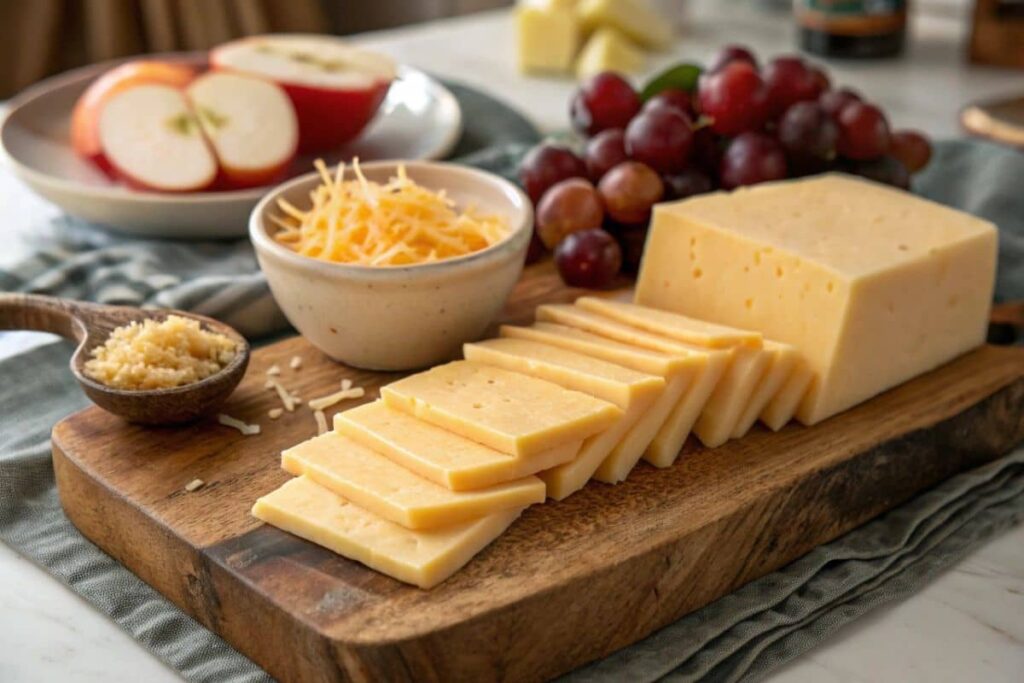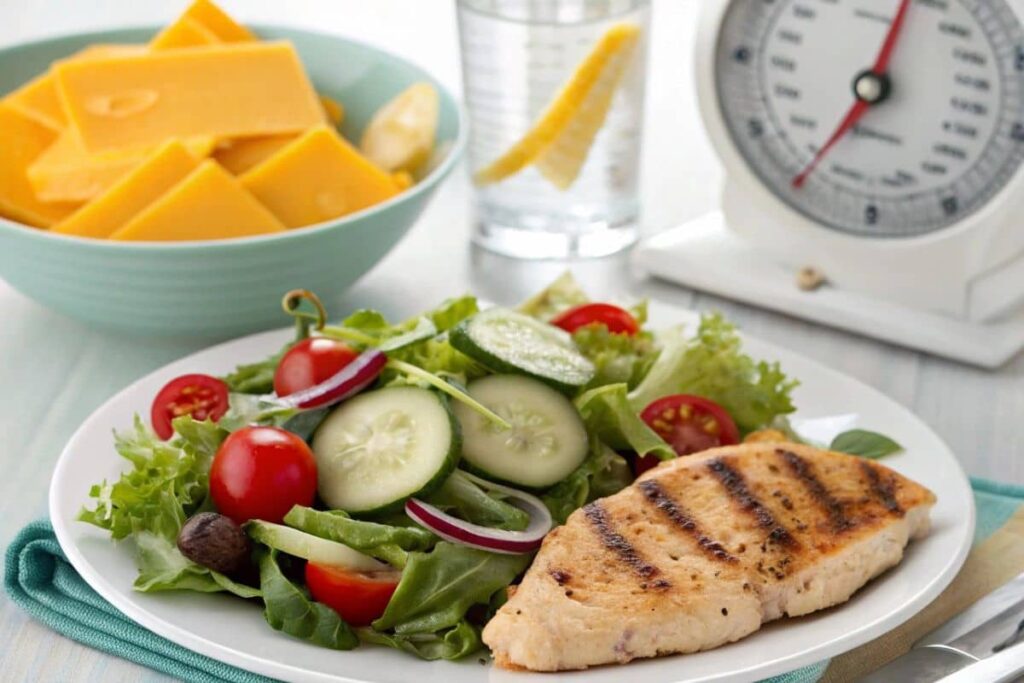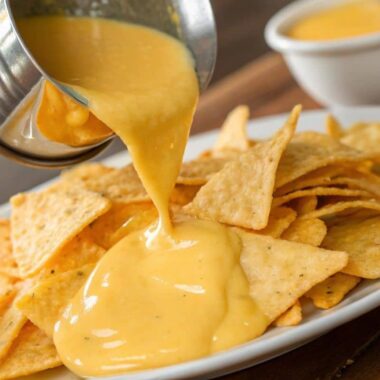Is cheddar the healthiest cheese to eat? It’s creamy, tangy, and a favorite in countless dishes. But here’s the big question—can it truly be considered a healthy choice? Let’s dive into everything cheddar-related to find out if it deserves the title of “healthiest cheese.” Whether you love it melted on a sandwich, shredded over pasta, or enjoyed as a snack, there’s more to cheddar than meets the eye!
Table of Contents

Introduction to Cheddar Cheese
What Is Cheddar Cheese?
Cheddar cheese is a firm, aged cheese that originated in Cheddar, England (hence the name). It’s made from cow’s milk and comes in a range of flavors, from mild to extra sharp, depending on how long it’s aged. Mild cheddar is aged for about 2–3 months, while sharp cheddar can mature for over a year.
The History and Popularity of Cheddar
Cheddar has been around since the 12th century and has become one of the most widely consumed cheeses worldwide. Its versatility and rich flavor make it a top pick for everything from grilled cheese sandwiches to casseroles. But did you know cheddar’s popularity isn’t just about taste? It also has some surprising nutritional benefits that we’ll explore further!
“Cheddar isn’t just cheese; it’s a culinary superstar that’s been winning hearts (and taste buds) for centuries.”
Nutritional Profile of Cheddar Cheese
Is cheddar the healthiest cheese to eat? Before we determine the answer, let’s break down its nutritional content. Understanding what’s inside your cheese can help you make informed choices about your diet. Here’s what cheddar brings to the table:
Calories and Macronutrients
| Nutrient | Amount (per 1 oz/28g) |
|---|---|
| Calories | 113 |
| Protein | 7g |
| Fat | 9g |
| Saturated Fat | 6g |
| Carbohydrates | 0.4g |
| Sodium | 174mg |
| Calcium | 200mg |
As you can see, cheddar cheese is calorie-dense, primarily because of its fat content. However, it’s also a good source of protein and calcium, which are essential for overall health. 🧀
Key Vitamins and Minerals in Cheddar
Cheddar cheese is more than just a protein powerhouse. It’s also packed with essential vitamins and minerals:
- Calcium: Vital for strong bones and teeth.
- Vitamin A: Supports vision, skin health, and immune function.
- Vitamin B12: Helps maintain energy levels and a healthy nervous system.
- Phosphorus: Works alongside calcium to strengthen bones.
How Cheddar Compares to Other Cheeses
Compared to soft cheeses like brie or mozzarella, cheddar contains higher levels of protein and fat. This makes it more satisfying and a better option for keeping you full. On the flip side, cheddar has more calories and sodium than lighter options like feta or goat cheese. So, while it’s nutritious, moderation is key.
Health Benefits of Cheddar Cheese
High in Calcium for Strong Bones
One of the reasons people often ask, “Is cheddar the healthiest cheese to eat?”, is its impressive calcium content. Just one ounce provides 20% of your daily calcium needs, making it an excellent choice for growing teens and anyone focused on maintaining strong, healthy bones. This nutrient-packed cheese certainly has its health perks!
Good Source of Protein for Muscle Health
Protein isn’t just for bodybuilders—it’s essential for everyone. Cheddar cheese offers 7 grams of high-quality protein per ounce, helping repair and build muscle tissue. Whether you’re active or just trying to meet your daily protein goals, cheddar can help you get there. So, the next time you wonder, “Is cheddar the healthiest cheese to eat?”, remember its powerful protein punch!
Contains Beneficial Fats for Energy
Yes, cheddar cheese is high in fat, but not all fats are bad! It contains beneficial fats that provide long-lasting energy and help the body absorb fat-soluble vitamins like A and D. These fats are especially helpful for active individuals or those on a low-carb diet. With its energy-boosting properties, you might find yourself thinking, “Is cheddar the healthiest cheese to eat?” It’s certainly a contender for a balanced, energy-filled diet!
“Think of cheddar cheese as a little powerhouse of nutrition—it fuels your body while satisfying your cravings.”
Common Concerns About Cheddar Cheese
Is Cheddar High in Fat?
It’s true—cheddar cheese is high in fat, with about 9 grams per ounce. However, most of these fats are saturated, which has been debated for its effects on heart health. While moderate consumption is perfectly fine for most people, those watching their fat intake should opt for reduced-fat cheddar varieties.
Sodium Content: Should You Be Worried?
Cheddar cheese does have a significant amount of sodium (174mg per ounce). Excess sodium can contribute to high blood pressure, so it’s best to pair cheddar with low-sodium foods or enjoy it in smaller portions.
Lactose Intolerance and Cheddar
If you’re lactose intolerant, here’s some good news: aged cheddar contains very little lactose! During the aging process, most of the lactose is broken down, making it easier to digest compared to fresher cheeses like ricotta or cream cheese.
Comparing Cheddar with Other Cheeses

Cheddar vs. Mozzarella: Which Is Healthier?
When comparing cheddar and mozzarella, it’s a battle of taste versus health. Mozzarella is lower in calories, fat, and sodium, making it a lighter option for those watching their intake. However, cheddar packs more protein and calcium per ounce, which can be a better choice if you’re looking for a nutrient boost. Ultimately, your choice depends on your dietary goals and personal preferences!
Cheddar vs. Gouda: Key Nutritional Differences
Gouda and cheddar are both rich and flavorful cheeses, but they differ in texture and nutrition. Gouda is slightly creamier due to its higher fat content, while cheddar offers a sharper taste. Nutritionally, both are excellent sources of calcium and protein, but aged gouda contains beneficial probiotics, which can support gut health. So, when asking yourself, “Is cheddar the healthiest cheese to eat?”, consider what you’re looking for: cheddar for boldness or gouda for creaminess.
Cheddar vs. Blue Cheese: Pros and Cons
Blue cheese is a love-it-or-hate-it option, known for its strong aroma and tangy flavor. While cheddar is more versatile and widely accepted, blue cheese contains higher levels of probiotics, which are great for digestion. However, blue cheese also tends to be higher in fat and sodium, making cheddar the more balanced option for everyday use. For those pondering, “Is cheddar the healthiest cheese to eat?”, cheddar often strikes the right balance of flavor, nutrition, and versatility.
Tips for Choosing the Healthiest Cheddar Cheese
Opting for Aged Cheddar
Aged cheddar isn’t just richer in flavor—it’s also lower in lactose. As cheddar ages, its lactose content decreases, making it easier to digest for those with sensitivities. Plus, aged varieties often have a more complex taste, meaning you’ll need less to satisfy your cravings. If you’re still wondering, “Is cheddar the healthiest cheese to eat?”, aged cheddar might just make your decision easier with its enhanced flavor and digestive benefits.
Organic vs. Conventional Cheddar
If you’re concerned about additives or the quality of milk used in your cheese, consider opting for organic cheddar. Organic cheese is made from milk produced by cows that haven’t been treated with hormones or antibiotics. While it can be pricier, many people find the peace of mind worth the extra cost.
Low-Fat and Reduced-Sodium Options
For those watching their calorie or sodium intake, there are plenty of low-fat and reduced-sodium cheddar options available. While these might lack the full-bodied flavor of traditional cheddar, they’re a great compromise for maintaining a balanced diet.
How to Include Cheddar in a Healthy Diet
Portion Control: How Much Cheddar Is Too Much?
Cheddar cheese is nutrient-dense, which means a little goes a long way. Stick to a portion size of about 1 ounce (roughly the size of your thumb) to enjoy its benefits without overloading on calories or fat. If you’ve been asking yourself, “Is cheddar the healthiest cheese to eat?”, portion control is one of the easiest ways to make it a healthy part of your diet. Remember, moderation is key to unlocking cheddar’s benefits while avoiding overindulgence.
Pairing Cheddar with Nutrient-Dense Foods
Balance is everything when it comes to healthy eating. Pair cheddar cheese with foods like whole-grain crackers, fresh vegetables, or lean proteins for a well-rounded meal or snack. For instance, add a slice of cheddar to a turkey sandwich loaded with lettuce and tomato for a nutritious and satisfying lunch. These smart pairings can make you feel good about enjoying cheddar while keeping your diet balanced. So, “Is cheddar the healthiest cheese to eat?” When paired wisely, it can certainly hold its own among the healthiest options.
Healthy Recipes Using Cheddar Cheese
Cheddar cheese isn’t just tasty; it’s incredibly versatile. With a little creativity, you can use it to make healthy meals and snacks that are both satisfying and nutritious. Whether it’s melted into a veggie-packed omelet, stuffed into bell peppers, or paired with apple slices for a quick snack, the possibilities are endless. If you’re exploring, “Is cheddar the healthiest cheese to eat?”, experimenting with wholesome recipes is a delicious way to find out!

Cheddar and Veggie Omelet
Ingredients
- 2 large eggs
- 1/4 cup shredded cheddar cheese
- 1/4 cup chopped spinach
- 1/4 cup diced tomatoes
- 1/4 cup sliced mushrooms
- 1 tablespoon olive oil
- Salt and pepper to taste
Instructions
- Whisk the eggs in a small bowl with a pinch of salt and pepper.
- Heat olive oil in a non-stick pan over medium heat.
- Add the spinach, tomatoes, and mushrooms to the pan. Sauté for 2–3 minutes until softened.
- Pour the eggs over the veggies and let cook for 1–2 minutes.
- Sprinkle shredded cheddar cheese on one side of the omelet, fold it in half, and cook for another minute until the cheese melts.
- Slide the omelet onto a plate and enjoy a nutritious, cheesy start to your day!

Cheddar-Stuffed Bell Peppers
Ingredients
- 4 large bell peppers any color
- 1 cup cooked quinoa
- 1 cup black beans drained and rinsed
- 1 cup shredded cheddar cheese
- 1/2 cup diced tomatoes
- 1/4 cup chopped fresh parsley
- 1 teaspoon cumin
- Salt and pepper to taste
Instructions
- Preheat your oven to 375°F (190°C).
- Slice the tops off the bell peppers and remove the seeds and membranes.
- In a large bowl, mix the quinoa, black beans, diced tomatoes, parsley, cumin, and half of the cheddar cheese. Add salt and pepper to taste.
- Stuff each bell pepper with the mixture and place them in a baking dish.
- Sprinkle the remaining cheddar cheese on top of each pepper.
- Bake for 20–25 minutes or until the peppers are tender and the cheese is melted and golden.
- Serve warm for a filling, cheesy meal. 🌶️🧀

Cheddar and Apple Slices
Ingredients
- 1 medium apple sliced
- 2 ounces cheddar cheese sliced
- 1 tablespoon honey optional
- A sprinkle of cinnamon optional
Instructions
- Slice the apple and arrange the slices on a plate.
- Pair each apple slice with a slice of cheddar cheese.
- Drizzle honey over the top and sprinkle with cinnamon for added flavor, if desired.
- Enjoy this wholesome snack that’s perfect for any time of the day! 🍎🧀
“These recipes prove that cheddar cheese isn’t just delicious—it’s the perfect ingredient for adding flavor and nutrition to your meals!”
Common Myths About Cheddar Cheese
Is Cheddar Really “Unhealthy”?
Some people wonder, “Is cheddar the healthiest cheese to eat?”, because it’s often labeled as unhealthy due to its fat and calorie content. However, when consumed in moderation, cheddar is actually a nutrient-rich food packed with protein, calcium, and essential vitamins. Like most indulgences, it’s all about balance—enjoy it mindfully, and you’ll reap the benefits without the guilt!
Does Cheddar Cause Weight Gain?
Cheddar cheese itself doesn’t cause weight gain. The real issue lies in portion sizes. Overindulging in any food can lead to excess calorie intake. Stick to the recommended portions (about 1 ounce per serving), and you can enjoy cheddar without worry. So, the next time you ask, “Is cheddar the healthiest cheese to eat?”, remember that moderation is the key to making it a healthy part of your diet.
Are All Cheddar Cheeses the Same?
Nope! Cheddar cheese varies widely in flavor, texture, and nutritional content depending on how it’s made and aged. For instance, sharp cheddar has a bolder taste and lower moisture content compared to mild cheddar. If you’re debating, “Is cheddar the healthiest cheese to eat?”, choosing aged cheddar might offer additional benefits, like reduced lactose content and a richer flavor, making it easier to enjoy smaller portions.
Frequently Asked Questions About Cheddar Cheese

Can Cheddar Be Part of a Weight Loss Diet?
Absolutely! Cheddar cheese can fit into a weight loss diet when consumed in moderation. Its high protein content can keep you feeling full, making it easier to control your overall calorie intake.
Is Aged Cheddar Healthier Than Mild Cheddar?
Aged cheddar has some advantages—it’s lower in lactose and often richer in flavor, so you might use less of it. However, both aged and mild cheddar are nutritious options, so it really comes down to taste.
Can I Eat Cheddar Cheese Every Day?
You can enjoy cheddar daily as part of a balanced diet. Just be mindful of portion sizes and pair it with nutrient-dense foods for a healthy lifestyle.
Conclusion: Is Cheddar the Healthiest Cheese?
Summing Up the Pros and Cons
Cheddar cheese is a delicious and nutrient-rich option that offers plenty of health benefits, from supporting bone health with its high calcium content to providing high-quality protein for muscle health. That said, it’s also calorie-dense and contains significant amounts of sodium, which means moderation is essential. If you’ve ever asked yourself, “Is cheddar the healthiest cheese to eat?”, the answer depends on how it fits into your overall diet and lifestyle.
Final Thoughts on Cheddar’s Place in a Balanced Diet
At the end of the day, cheddar cheese is a fantastic choice for most people when enjoyed in reasonable amounts. It’s versatile, satisfying, and packed with flavor—making it an easy addition to a healthy diet. Whether you prefer it melted, shredded, or sliced, cheddar brings both taste and nutrition to the table. So, is cheddar the healthiest cheese? It’s certainly a strong contender for those seeking a delicious and nutrient-packed cheese! 🧀
While cheddar cheese is undeniably a fantastic choice, why not explore other delicious options too? Dive into the tangy world of blue cheese, savor the creamy richness of gouda cheese, or experience the nutty elegance of gruyere cheese. And if you’re feeling inspired, try creating your own cheesy masterpiece with our guide on how to make cheddar cheese sauce. Each cheese offers unique flavors and benefits, making it easy to find your perfect match!





